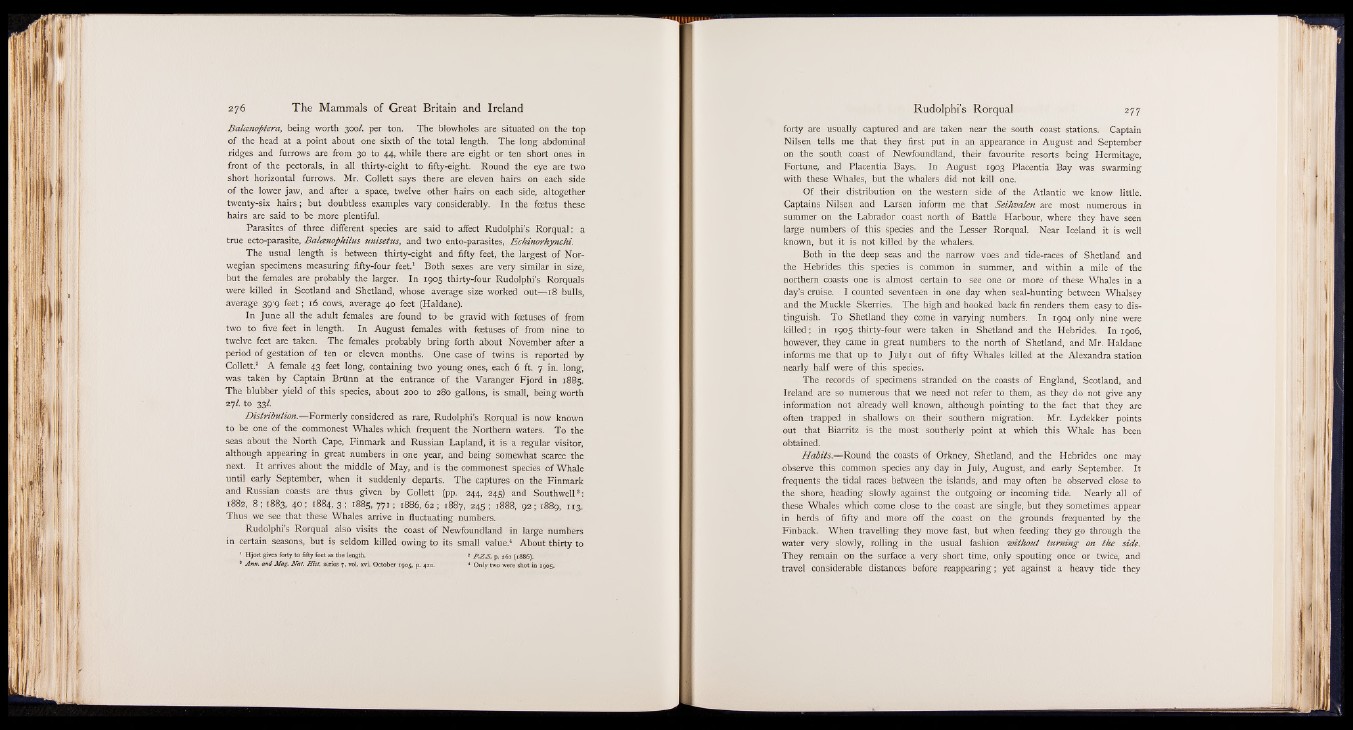
Balcenoptera, being worth 300/. per ton. The blowholes are situated on the top
of the head at a point about one sixth of the total length. The long abdominal
ridges and furrows are from 30 to 44, while there are eight or ten short ones in
front of the pectorals, in all thirty-eight to fifty-eight. Round the eye are two
short horizontal furrows. Mr. Collett says there are eleven hairs on each side
of the lower jaw, and after a space, twelve other hairs on each side, altogether
twenty-six hairs; but doubtless examples vary considerably. In the foetus these
hairs are said to be more plentiful.
Parasites of three different species are said to affect Rudolphi’s Rorqual: a
true ecto-parasite, Balanophilus unisetus, and two ento-parasites, Echinorhyncki.
The usual length is between thirty-eight and fifty feet, the largest of Norwegian
specimens measuring fifty-four feet.1 Both sexes are very similar in size,
but the females are probably the larger. In 1905 thirty-four Rudolphi’s Rorquals
were killed in Scotland and Shetland, whose average size worked out— 18 bulls,
average 39-9 feet ; 16 cows, average 40 feet (Haldane). hV
In June all the adult females are found to be gravid with foetuses of from
two to five feet in length. In August females with foetuses of from nine to
twelve feet are taken. The females probably bring forth about November after a
period of gestation of ten or eleven months. One case of twins is reported by
Collett.2 A female 43 feet long, containing two young ones, each 6 ft. 7 in. long,
was taken by Captain Briinn at the entrance of the Varanger Fjord in 1885.
The blubber yield of this species, about 200 to 280 gallons, is small, being worth
27/. to 33/.
Distribution.— Formerly considered as rare, Rudolphi’s Rorqual is now known
to be one of the commonest Whales which frequent the Northern waters. To the
seas about the North Cape, Finmark and Russian Lapland, it is a regular visitor,
although appearing in great numbers in one year, and being somewhat scarce the
next. It arrives about the middle of May, and is the commonest species of Whale
until early September, when it suddenly departs. The captures on the Finmark
and Russian coasts are thus given by Collett (pp. 244, 245) and Southwell8:
1882, 8; 1883, 40; 1884, 3I 1885, 771; 1886, 62; 1887, 245 ; 1888, 92; 1889, 113.
Thus we see that these Whales arrive in fluctuating numbers.
Rudolphi’s Rorqual also visits the coast of Newfoundland in large numbers
in certain seasons, but is seldom killed owing to its small value.4 About thirty to
’ Hjort gives forty to fifty feet as the length. > P .Z .S . p. 261 (1886).
* Ann. and Mag. Nat. H ist, series 7, vol. xvi. October 1905, p. 420. * Only two were shot in 1905.
forty are usually captured and are taken near the south coast stations. Captain
Nilsen tells me that they first put in an appearance in August and September
on the south coast of Newfoundland, their favourite resorts being Hermitage,
Fortune, and Placentia Bays. In August 1903 Placentia Bay was swarming
with these Whales, but the whalers did not kill one.
Of their distribution on the western side of the Atlantic we know little.
Captains Nilsen and Larsen inform me that Seihvalen are most numerous in
summer on the Labrador coast north of Battle Harbour, where they have seen
large numbers of this species and the Lesser Rorqual. Near Iceland it is well
known, but it is not killed by the whalers.
Both in the deep seas and the narrow voes and tide-races of Shetland and
the Hebrides this species is common in summer, and within a mile of the
northern coasts one is almost certain to see one or more of these Whales in a
day’s cruise. I counted seventeen in one day when seal-hunting between Whalsey
and the Muckle Skerries. The high and hooked back fin renders them easy to distinguish.
To Shetland they come in varying numbers. In 1904 only nine were
killed; in 1905 thirty-four were taken in Shetland and the Hebrides. In 1906,
however, they came in great numbers to the north of Shetland, and Mr. Haldane
informs me that up to Julyi out of fifty Whales killed at the Alexandra station
nearly half were of this species.
The records of specimens stranded on the coasts of England, Scotland, and
Ireland are so numerous that we need not refer to them, as they do not give any
information not already well known, although pointing to the fact that they are
often trapped in shallows on their southern migration. Mr. Lydekker points
out that Biarritz is the most southerly point at which this Whale has been
obtained.
Habits.— Round the coasts of Orkney, Shetland, and the Hebrides one may
observe this common species any day in July, August, and early September. It
frequents the tidal races between the islands, and may often be observed close to
the shore, heading slowly against the outgoing or incoming tide. Nearly all of
these Whales which come close to the coast are single, but they sometimes appear
in herds of fifty and more off the coast on the grounds frequented by the
Finback. When travelling they move fast, but when feeding they go through the
water very slowly, rolling in the usual fashion without turning on the side.
They remain on the surface a very short time, only spouting once or twice, and
travel considerable distances before reappearing; yet against a heavy tide they